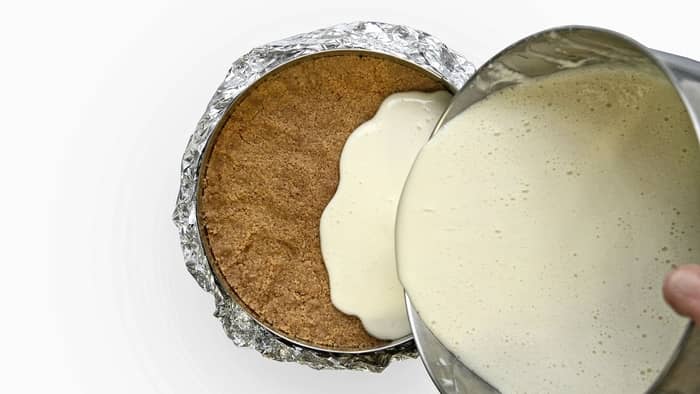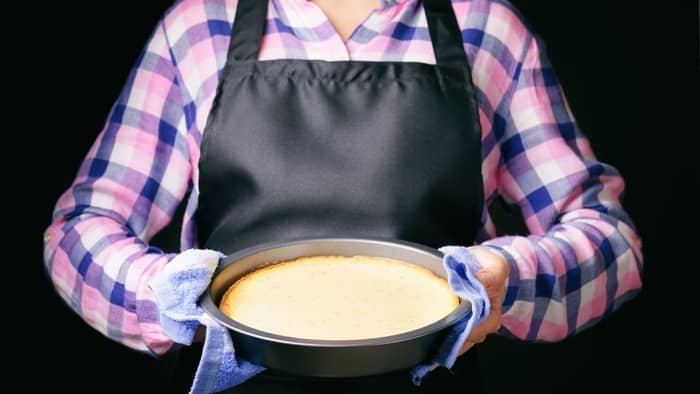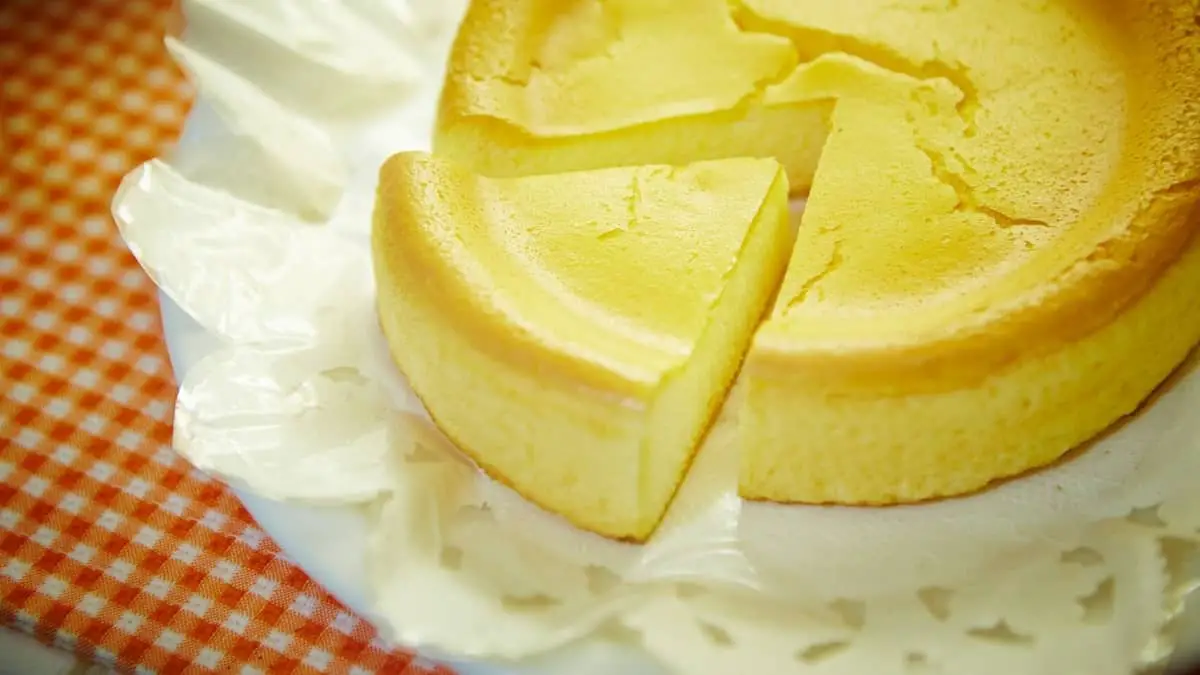By Lindy Van Schalkwyk, last updated on October 3, 2024
Today, we will explore the many reasons that these goods crack and the best ways of preventing cheesecake from cracking. Ready to get started?
How Are Cheesecakes Made? – Understanding Ways To Preventing Cheesecake From Cracking
Now, this may seem like a strange part to start. But, by understanding how cheesecakes are made, baked, and cooled, you can more easily recognize where the fault lies when you have cracked cheesecake.
Preparation
Now, first, a better is made using a combination of cream cheese, sugar, eggs, and sometimes a liquid. First, the cream cheese is beaten to become light and fluffy. It helps create a smooth airy texture that is a trademark of cheesecake.
Then, the sugar is also beaten with cream cheese. This will allow the sugar granules to completely dissolve. If they aren’t dissolved, they will create a grainy texture if your cheesecake batter that isn’t very appealing.
Now, you can add your eggs in a couple of ways. The first is by simply adding them whole. You should only add one egg at a time and incorporate them thoroughly. Alternatively, only egg yolks can be added to the cream cheese. The egg whites can be beaten to medium or stiff peaks and folded in. This technique will create an uber airy soft texture.
And finally, once your eggs have been incorporated, you can adjust the consistency with a liquid such as cream, milk, or sour cream. You can also add any flavoring extracts or essences.

Baking
Once your batter has been made, it is time to bake your cheesecake. Always bake it inside of a preheated oven at a relatively high temperature. Your oven should have a stable temperature.
Also, you mustn’t over-bake the cheesecake. You guessed it! Over-baked cheesecakes do often crack because of how dry they have become.
Your average 10-inch cheesecake will bake anywhere between 45-60 minutes.
Cooling
While there are many debates surrounding the proper way to cool a cheesecake, our technique is fool-proof.
First, once the cheesecake has been fully baked, simply switch off the oven and slightly crack the oven door. Allow the cheesecake to cool n there for about an hour. Then, remove it from the oven, set it on a wire rack, and cool it at room temperature for another hour.
Finally, wrap the entire pan with plastic or saran wrap and allow the cheesecake to set inside of the fridge. It should be ready within 4-6 hours, but we prefer keeping it there overnight.
What Causes A Cheesecake To Crack?
So, there are many reasons for a cheesecake cracking on top. That is why we have broken down the process for you above so you can easily find where you went wrong. This will help with preventing cheesecake from cracking.
Over-mixing the batter
So, let’s start at the beginning. When you over mix a cheesecake batter, you are removing any air pockets that you can initially create. What this then does is create a much denser texture. Over mixing also weaken any bonds that have been formed, which then won’t hold the structure of the ingredients when the cheesecake bakes.
The cracks form as follows. When the cheesecake bakes, the initial lift causes it to rise to the top. It will start solidifying there and will stick to the sides. Then, because there isn’t any structural support, the cheesecake batter will sink in. However, because the sides are now stuck, a crack forms when the batter deflates.
Over-baking the cheesecake
When you bake a cheesecake for too long you are completely drying it out. While baking, the cheesecake contracts a lot. Then, once cooled, the bonds relax which then creates tiny little tears in the top of the cheesecake.
Incorrect cooling
Cheesecakes almost always crack during the cooling period. This is because very few people actually know how to correctly do so. Or, maybe they are just too impatient.
Sudden drastic temperature changes will cause the cheesecake to crack. That is why our techniques work so great. You are slowly decreasing the temperature of the cheesecake without shocking it.
Furthermore, any drafts could cause the cheesecake to collapse which then creates tears.
Incorrect recipe ratios
Last n our list of causes for cracks is incorrect recipe ratios. Now, this is often an overlooked reason However, if you know that you have done everything by the book and you still get cracks, it is probably the recipe.
If your recipe doesn’t provide enough structural support for the rest of the ingredients, the cake will rise and fall, tearing straight down the middle.
Always choose recipes from reputable sites, like ours!

Preventing Cheesecake From Cracking
Now, let’s move on to ways of preventing cheesecake from cracking. And believe us, it’s easier than you may think!
Step 1: Do not over mix your batter
Never over mix your cheesecake batter. This can be done by using only softened and room-temperature ingredients. This will make them easier to combine into a smooth mix and prevent any lumps from forming.
Often, once lumps have formed, people try desperately to salvage the batter by continuously mixing the ingredients.
Furthermore, only mix the ingredients until they are just combined. This is especially crucial when adding the eggs. Only add one egg at a time to create a stable mixture. If you add all of them, it might make it difficult to incorporate, ultimately causing you to over mix it.
Step 2: Do not over bake your cheesecake
On average, a cheesecake will bake at 350°F (180°C) for roughly 40-60 minutes. Do not open the oven during baking time. Only once about three-quarters of the time has elapsed can you open the door slightly.
Then, check the doneness of the cheesecake by giving it a gentle wiggle. Only the center 1 to 2-inches should still wobble like jelly. The sides should be set but not dry. Once you reach this point, your cheesecake has finished baking. The residual heat will continue to solidify the center while the rest starts cooling.
Step 3: Properly cool your cheesecake
This one is very easy. You can follow the steps that we have laid out above and also keep the cake away from any drafts. We know this process takes some time, but that’s exactly what makes cheesecake so incredibly popular and delicious.
Wrapping It Up – Preventing Cheesecake From Cracking
As you can see, preventing cheesecake from cracking is actually easier than many people think. It mostly comes down to proper baking and cooling methods.
If you still have any questions about this topic, feel free to ask us in the comments below. And, share this article with your fellow cheesecake-bakers to help them too!
FAQs
[rank_math_rich_snippet id=”s-361c7c03-0041-43f9-acfa-2b958c7ba29f”]

Lindy Van Schalkwyk is a culinary specialist with a background in Advanced Cooking, Advanced Pâtisserie, Media Communications and Nutrition. She has gained invaluable experience in the culinary industry having worked in some of the top restaurants in Africa in 2016 and 2017. Her expertise in nutrition has enabled her to develop recipes for special dietary needs. In 2018, Lindy began working in the Food Media industry, focusing on recipe development, recipe writing, food writing and food styling.

